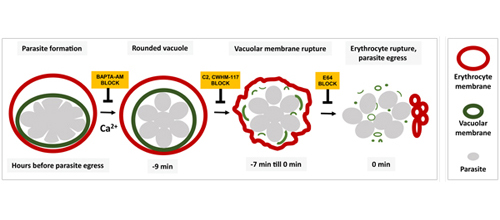Findings could inform the development of new antimalarial drugs

Diagram of the sequence of events involved in rupture of the vacuole and host cell membrane leading to release of the malaria parasite. Using chemical inhibitors, the researchers showed that it’s possible to block each event in the sequence. Abbreviations key: BAPTA-AM (bis--N,N,N',N'-tetraacetic acid-AM); C2 (compound 2, or 4-[7-[(dimethylamino)methyl]-2-(4-fluorphenyl)imidazo[1,2-α]pyridine-3-yl]pyrimidin-2-amine); CWHM‐117 (Aminohydantoin compound 8p); E-64 (cysteine protease inhibitor). Credit: NICHD/NIH
WHAT:
The vacuole, a compartment inside human red blood cells in which malaria parasites reproduce and develop, takes on a distinct spherical shape just minutes before its membrane ruptures, leading to the release of parasites into the blood stream, according to researchers at the National Institutes of Health and other institutions. Their study appears in Cellular Microbiology.
The researchers, working with red blood cells from healthy donors, were able to chemically block the sequence of events leading to this rounding of the vacuole. They note that targeting this sequence could inform new treatment strategies against Plasmodium falciparum, the species of malaria parasite that causes the most deaths worldwide and, in several areas, has become drug-resistant.
To track the rounding sequence under a microscope, researchers dyed the membrane of the vacuole with a substance that gives off green light. About 10 minutes before the membrane ruptured, the vacuole morphed from a lumpy, uneven shape to a sphere. Previous studies have shown that malaria parasites use calcium to trigger the biochemical reactions needed for their release from the cell. When the researchers treated the cells with a compound that blocks calcium’s effect, the vacuoles couldn’t transition to the spherical form, trapping the parasites inside the cell.
WHO:
Joshua Zimmerberg, M.D., Ph.D., Section on Integrative Biophysics, Eunice Kennedy Shriver National Institute of Child Health and Human Development, is available for comment.
ARTICLE:
Glushakova S. Rounding precedes rupture and breakdown of vacuolar membranes before malaria parasite egress from erythrocytes. Cellular Microbiology. 2018;e12868. https://doi.org/10.1111/cmi.12868
###
This press release describes a basic research finding. Basic research increases our understanding of human behavior and biology, which is foundational to advancing new and better ways to prevent, diagnose, and treat disease. Science is an unpredictable and incremental process—each research advance builds on past discoveries, often in unexpected ways. Most clinical advances would not be possible without the knowledge of fundamental basic research.
About the Eunice Kennedy Shriver National Institute of Child Health and Human Development (NICHD): NICHD conducts and supports research in the United States and throughout the world on fetal, infant and child development; maternal, child and family health; reproductive biology and population issues; and medical rehabilitation. For more information, visit NICHD’s website.
About the National Institutes of Health (NIH): NIH, the nation's medical research agency, includes 27 Institutes and Centers and is a component of the U.S. Department of Health and Human Services. NIH is the primary federal agency conducting and supporting basic, clinical, and translational medical research, and is investigating the causes, treatments, and cures for both common and rare diseases. For more information about NIH and its programs, visit http://www.nih.gov.

 BACK TO TOP
BACK TO TOP